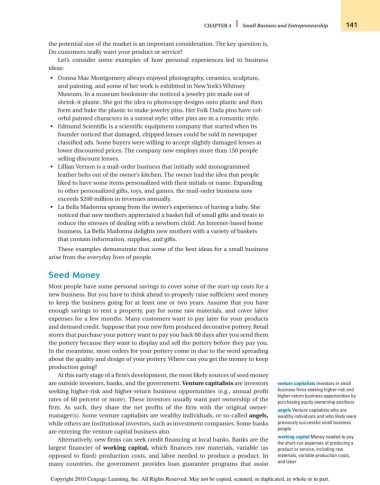Page 167 - Introduction to Business
P. 167
CHAPTER 4 Small Business and Entrepreneurship 141
the potential size of the market is an important consideration. The key question is,
Do customers really want your product or service?
Let’s consider some examples of how personal experiences led to business
ideas:
• Donna Mae Montgomery always enjoyed photography, ceramics, sculpture,
and painting, and some of her work is exhibited in New York’s Whitney
Museum. In a museum bookstore she noticed a jewelry pin made out of
shrink-it plastic. She got the idea to photocopy designs onto plastic and then
form and bake the plastic to make jewelry pins. Her Folk Dada pins have col-
orful painted characters in a surreal style; other pins are in a romantic style.
• Edmund Scientific is a scientific equipment company that started when its
founder noticed that damaged, chipped lenses could be sold in newspaper
classified ads. Some buyers were willing to accept slightly damaged lenses at
lower discounted prices. The company now employs more than 150 people
selling discount lenses.
• Lillian Vernon is a mail-order business that initially sold monogrammed
leather belts out of the owner’s kitchen. The owner had the idea that people
liked to have some items personalized with their initials or name. Expanding
to other personalized gifts, toys, and games, the mail-order business now
exceeds $200 million in revenues annually.
• La Bella Madonna sprang from the owner’s experience of having a baby. She
noticed that new mothers appreciated a basket full of small gifts and treats to
reduce the stresses of dealing with a newborn child. An Internet-based home
business, La Bella Madonna delights new mothers with a variety of baskets
that contain information, supplies, and gifts.
These examples demonstrate that some of the best ideas for a small business
arise from the everyday lives of people.
Seed Money
Most people have some personal savings to cover some of the start-up costs for a
new business. But you have to think ahead to properly raise sufficient seed money
to keep the business going for at least one or two years. Assume that you have
enough savings to rent a property, pay for some raw materials, and cover labor
expenses for a few months. Many customers want to pay later for your products
and demand credit. Suppose that your new firm produced decorative pottery. Retail
stores that purchase your pottery want to pay you back 60 days after you send them
the pottery because they want to display and sell the pottery before they pay you.
In the meantime, more orders for your pottery come in due to the word spreading
about the quality and design of your pottery. Where can you get the money to keep
production going?
At this early stage of a firm’s development, the most likely sources of seed money
are outside investors, banks, and the government. Venture capitalists are investors venture capitalists Investors in small
seeking higher-risk and higher-return business opportunities (e.g., annual profit business firms seeking higher-risk and
higher-return business opportunities by
rates of 60 percent or more). These investors usually want part ownership of the
purchasing equity ownership positions
firm. As such, they share the net profits of the firm with the original owner-
angels Venture capitalists who are
manager(s). Some venture capitalists are wealthy individuals, or so-called angels, wealthy individuals and who likely were
while others are institutional investors, such as investment companies. Some banks previously successful small business
people
are entering the venture capital business also.
working capital Money needed to pay
Alternatively, new firms can seek credit financing at local banks. Banks are the
the short-run expenses of producing a
largest financier of working capital, which finances raw materials, variable (as product or service, including raw
opposed to fixed) production costs, and labor needed to produce a product. In materials, variable production costs,
many countries, the government provides loan guarantee programs that assist and labor
Copyright 2010 Cengage Learning, Inc. All Rights Reserved. May not be copied, scanned, or duplicated, in whole or in part.

